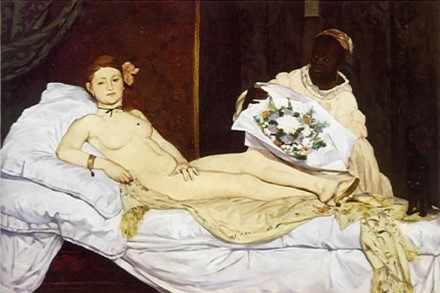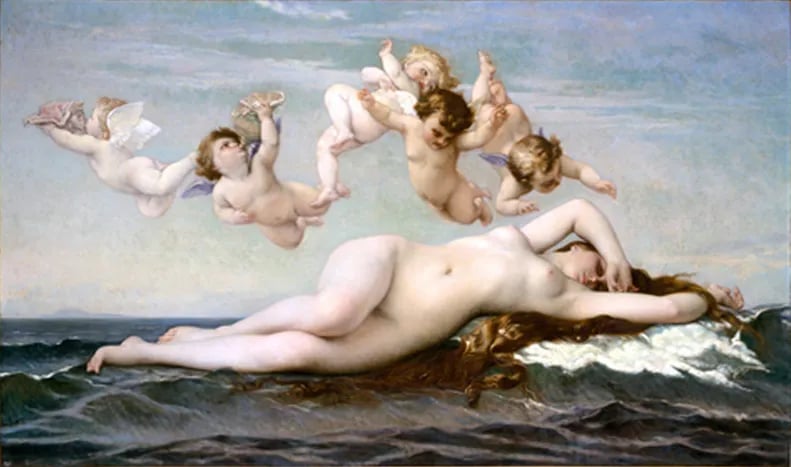free shipping , free return
The Painting That Nearly Started a Riot
Manet's Olympia and the Fury of the Paris Salon
4/7/20254 min read


The Painting That Nearly Started a Riot: Manet's Olympia and the Fury of the Paris Salon
Art galleries today often feel like quiet, contemplative spaces. We wander, we observe, perhaps we feel moved or intrigued. But can you imagine a painting causing such public outrage that it needed guards to protect it from physical attack? It sounds dramatic, almost unbelievable, yet it happened. In 1865 Paris, one painting shocked, offended, and enraged the public and critics alike, marking a pivotal moment in art history. The culprit? Édouard Manet's Olympia.
Setting the Scene: The Paris Salon of 1865
To understand the explosion Olympia caused, we need to understand the context. Mid-19th century Paris was the center of the art world, and the annual Salon, organized by the prestigious Académie des Beaux-Arts, was the place for an artist to gain recognition, commissions, and potentially, fame. The Salon favoured a specific style: Academic art. This meant highly finished paintings, often depicting historical, mythological, or allegorical scenes. Nudes were acceptable, even celebrated, but only if they were idealized, distant figures – goddesses like Venus, nymphs, or historical heroines, rendered with smooth skin, modest poses, and classical proportions. They were objects of beauty, safely removed from everyday reality.
Enter Manet and His Uncompromising Vision
Édouard Manet was already known for pushing boundaries. Two years earlier, his Le Déjeuner sur l'herbe (Luncheon on the Grass), featuring a contemporary nude woman casually picnicking with fully clothed men, had been rejected by the official Salon but caused a stir at the alternative Salon des Refusés (Salon of the Rejected).
When Olympia was accepted into the official 1865 Salon, perhaps the jury didn't fully grasp its explosive potential, or perhaps they couldn't deny Manet's technical skill despite his challenging subject. The painting depicts a reclining nude woman on a bed, attended by a Black servant presenting a bouquet of flowers, while a black cat stands alert at the foot of the bed.
The Eruption: Shock, Mockery, and Outrage
The reaction was immediate and violent. The public, accustomed to the polished, idealized nudes of the Academy, was horrified. Crowds gathered around the painting, not in admiration, but in derision and anger. Contemporary accounts describe laughter, jeers, insults, and even threats of physical violence against the canvas. The painting had to be moved high above a doorway, and eventually, guards were posted to prevent it from being damaged.
So, what exactly caused such visceral fury? It wasn't just the nudity – the Salon was full of nudes. It was who this nude was, how she was painted, and how she looked back.
Why the Fury? Deconstructing the Scandal
The Subject: Not Venus, but Victorine (and a Courtesan): This wasn't a goddess. Viewers immediately recognized the model, Victorine Meurent (who also posed for Déjeuner sur l'herbe), and understood the figure not as a mythical being, but as a contemporary Parisian prostitute or high-class courtesan. "Olympia" itself was a common professional name used by sex workers at the time. Manet wasn't hiding reality behind myth; he was confronting the Parisian bourgeoisie with a stark aspect of their own society, one they preferred to keep hidden or romanticized. She wasn't coyly alluring; she seemed business-like.
The Gaze: Confrontational and Unashamed: Unlike traditional nudes who often look away demurely or offer a soft, inviting gaze, Olympia stares directly out at the viewer. Her look is cool, appraising, almost defiant. She is not a passive object of desire; she is aware, in control, challenging the viewer's (presumed male) gaze. This was deeply unsettling. It stripped away the comfortable fantasy and replaced it with an uncomfortable transaction.
[Image: Close-up detail of Olympia's face, highlighting her direct gaze.]
The Style: "Unfinished" and "Ugly": Manet rejected the smooth, meticulously blended finish favoured by the Academy. His brushwork is visible, almost harsh. He used stark contrasts of light and shadow, flattening the figure rather than using subtle modeling (chiaroscuro) to create a sense of rounded form. Critics lambasted the style as incompetent, crude, even childlike. They called Olympia "jaundiced," "corpse-like," comparing her skin to rubber or marble, devoid of sensual warmth. Her hand, pressed flat against her thigh, was seen as particularly graceless. To eyes trained on Academic perfection, it looked deliberately ugly and unfinished.
[Image: Detail showing Manet's relatively flat application of paint and visible brushstrokes on Olympia's body or the sheets.]
Subverted Symbolism: Manet included details that referenced classical art but twisted their meaning. The reclining pose echoed Titian's famous Venus of Urbino (a highly respected Renaissance masterpiece), but the comparison only highlighted Olympia's modernity and lack of idealization. Instead of a sleeping lapdog (symbolizing fidelity) as in Titian's painting, Olympia has a startled black cat (often associated with witchcraft, promiscuity, or ill-omen). The servant isn't a classical attendant but a contemporary Black woman, and the flowers are likely a gift from a client, grounding the scene firmly in the present-day world of Parisian commerce and sexuality.
[Image: Side-by-side comparison: Titian's "Venus of Urbino" (1538) next to Manet's "Olympia" (1863). Optional: Detail of Olympia's black cat.]
Art as a Mirror (That Society Didn't Want to Look Into)
Ultimately, Olympia sparked fury because it shattered conventions on multiple levels. It broke artistic rules with its style and technique. It broke social rules by presenting a contemporary, unidealized, confrontational image of a prostitute within the hallowed halls of high art. It forced viewers to confront the realities of class, sex, and power in their own modern world, rather than escaping into idealized fantasy. Manet held up a mirror, and many people violently rejected the reflection.
Legacy: From Scandal to Masterpiece
Despite the initial onslaught, Olympia became a foundational work of modern art. Manet's bold rejection of Academic constraints and his focus on contemporary reality paved the way for Impressionism and subsequent avant-garde movements. The very aspects that provoked outrage – the direct gaze, the flattened perspective, the visible brushwork, the modern subject matter – came to be seen as revolutionary and brilliant.
Today, Olympia hangs in the Musée d'Orsay in Paris, admired as a masterpiece. The fury it once incited serves as a powerful reminder that art isn't always meant to be comfortable. Sometimes, its greatest power lies in its ability to challenge, provoke, and force us to see the world, and ourselves, in a new, perhaps unsettling, light.




Inspired by your story
Our mission is to transform your spaces into masterpieces with creativity, quality, and care. From concept to installation, we’re dedicated to delivering exceptional wall decor that inspires and delights. Let’s create something extraordinary together.
Connect
Explore
Email: SJ@fineartheritage.com
© 2025. All rights reserved. Terms and conditions
